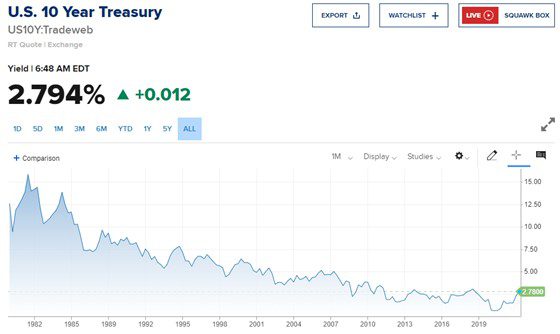
Westbury Reserve, Houston, TX
Good morning and welcome back to another Tuesday. I trust your week is off to a good start. I like to start my week by focusing on things that I’m thankful for – so if you haven’t had a chance to tell someone around you how much you appreciate them, here’s a reminder. I’m working on day 4 of a sinus headache from my allergies, so it’s definitely a good time to focus on the positive. Speaking of being positive, we’ve seen plenty of negativity recently coming out of the news media with regard to the stability of our economy. Let’s talk about interest rates.
INTEREST RATES GO UP, INTEREST RATES GO DOWN
I find it interesting that less than a month into a rising interest rate environment, where rates have gone up 1.5 points, it’s as though they’re headed up forever.
I’m not a market timer so I try to stay out of predicting the future. Rates go up, rates go down – our job is to ensure we’re getting a good deal regardless of where rates are. And from an acquisitions standpoint, if the economy really did weaken and scared people out of investing, one would assume valuations would go down. So if you’re focused on cash flow, it’s a prime time to buy.
INTEREST RATE HISTORY
Take a look at the chart below. 40 years of history for the 10-year treasury – a benchmark for most borrowing in our space. Long term trend is pretty obvious. And along the way there have been plenty of “blips” upward. If I were to go with the law of averages, that’s what we’re seeing today. It’s a healthy pullback. We must insert a small bit of caution into the market every few years to keep it from going completely crazy. Some people would note that the slope of the decrease has moderated over the last 10 years, and that is true, but remember– this is an absolute scale, not a logarithmic scale. We would expect that curve to flatten as it gets closer to zero because the percentage increase/decrease is a smaller absolute number.

INCREASED RATES, REVENUE, AND RENTS
For every action, there is an equal and opposite reaction. This isn’t completely true in economics, but it’s something to keep in mind. If rates go up a couple points, and we’re looking at less proceeds on a refinance because the debt service increased, the way to offset that would be with increased revenue (i.e. higher rents). So far that’s exactly what we’re seeing. Our overall revenue is increasing faster than projection but so are expenses. Overall our NOI is ahead of projections.
LIQUIDITY IN THE MARKET
The biggest question isn’t so much the technicalities of the current market condition as much as the liquidity of the market. When liquidity goes down, investors get worried. When investors get worried, the money stops flowing. The Fed has been very strategic about encouraging liquidity in the market because it reduces risk and keeps investors active. Over the last couple years, we saw a slight pullback, at times, from the agency lenders, for supplemental loans. On the flip side we’ve seen quite a few new entrants into the lending space that are looking to continue providing liquidity.
JOBS DRIVE MULTIFAMILY
And all of this is really a moot point anyway because there’s one thing that drives multifamily. JOBS. As sophisticated long-term investors we must keep our eye on the ball. I’m much more concerned about supply chain constraints on overall production than I am what happens with interest rates. Jobs drive multifamily and if those jobs go away or if people can’t make enough to pay the rent, we’re in trouble. Right now, it’s looking really good on that front.
THE REAL ISSUE
Wages are up, unemployment is down – businesses can’t find enough people to work. Secondly, with regard to supply chain constraints – if we can’t get the materials we need to complete our renovations, that will slow down our overall ability to raise rents. That’s been an issue for the past couple years now – not enough labor and shortages of supplies. And this is why the Fed has been so accommodating with money supply. The Fed has tried to offset this negative with plenty of liquidity. But there’s only so much they can do. And now, with inflation creeping up, that tool has become temporarily less useful.
PREPAREDNESS
Are there bumps along the road? Always. Are we prepared for them? Yes. Is our business model more of a long term “Warren Buffett” approach? Yes. Personally, I’d be happy if all of the multifamily flipping slowed down considerably. I don’t think it adds as much value to the resident as a long-term approach does. My hope is that we see some healthy fear in the market in 2022, and we’re able to pick up some good deals as a result!